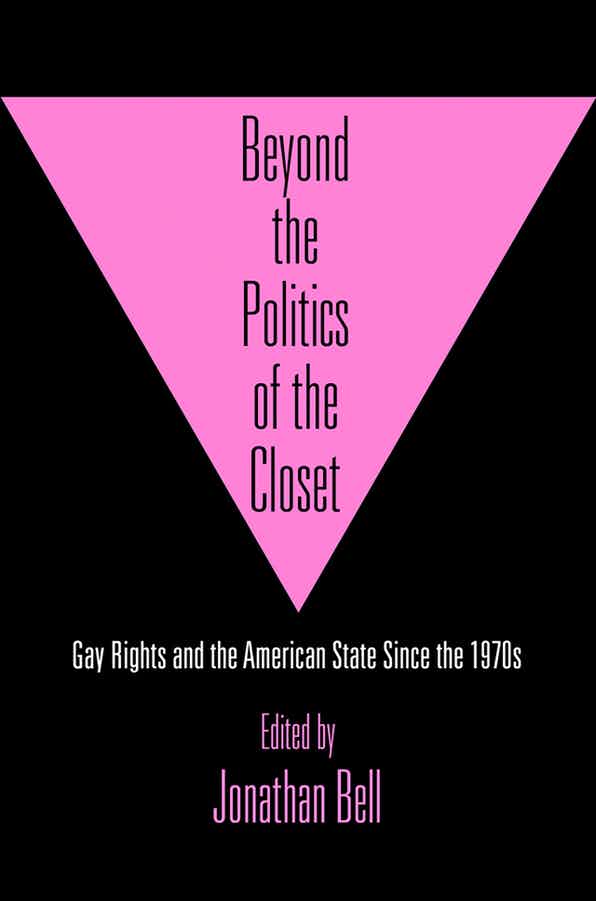The last quarter of the twentieth century saw LGBT rights in the United States alternately rise, resile, advance, and retrench. Transformations in the American state wrought by neoliberal policy reforms, particularly in the healthcare and housing sectors, impacted LGBT people in innumerable ways. Beyond the Politics of the Closet explores this tumultuous period, examining the reorientation of LGBT politics from the 1970s to the 1990s and interrogating the political narratives of that realignment. Edited by Jonathan Bell, the volume draws together historians and scholars of LGBT society and culture to offer a compelling investigation of this often oversimplified period of LGBT history. NOTCHES is grateful to the University of Pennsylvania Press and editor Jonathan Bell for permission to print this extract from the introduction.

Tim Stewart-Winter, one of the contributors to this volume, used the term “queer clout” as helpful shorthand for the complex ways in which gay rights activists, given new legitimacy and visibility in the wake of gay liberation, managed to gain access to the corridors of power in Chicago city politics. As several essays in this collection demonstrate, the process of coming-out in the 1970s and beyond was not simply an individual experience but rather a collective political project to harness economic as well as political power. Increased visibility for sexual minorities in society provided opportunities to develop specialist social services, such as health clinics and community organizations. Many of these collective projects were rooted firmly in the tradition of civil rights organizing and grassroots politics and were suspicious of traditional modes of power brokering in city halls, state legislatures, and political parties. Nevertheless, the period after 1970 saw the gradual erosion of the heteronormative certainties of state power as gay rights activists sought funding for social services and access to welfare and health benefits and mobilized against conservative ballot initiatives and legislation designed to block their legal rights. These battles took place in the context of the collapse of the New Deal political order and the advance of a neoliberal economic and political agenda in the Reagan years, developments that have worked to obscure the place of sexual minorities in wider U.S. politics.[vii] Indeed, the whole New Deal order analytical landscape of twentieth-century American history needs to consider the resolutely heteronormative ideological fundamentals of New Deal statecraft. An apparent golden age of strong labor unions, high wages, robust private health and social benefits, and impressive levels of economic growth provides only one narrative among many for an understanding of modern political history.[viii] Gay rights organizations pushing for greater access to the fruits of economic and social citizenship may have faced a world in which the New Deal social safety net was increasingly precarious and under attack, but this does not mean that their efforts to extend their civil rights beyond the purely legal were insignificant. State governments in particular expanded their policy-making reach in the 1970s and 1980s to include LGBT peoples in terms of not simply civil rights laws but also laws relating to health care access, among other things.
A foregrounding of LGBT issues in the wider public sphere in terms of clout has often examined queer Americans as consumers or as economic actors under capitalism. Spending power was an important tool in the arsenal of campaigns for equality, and businesses specifically catering for an LGBT clientele form an important part of the story of civil rights for sexual minorities in the late twentieth century as well as a lens onto the socioeconomic and racial divisions bisecting queer communities. In the 1980s, a decade of heightened vilification of poor and minority populations and of a wholesale political assault on those dependent upon government for welfare and health services, privileged access to private capital for economic security became a central concern of many LGBT activists during the AIDS crisis, evidence of the maturation of sexual nonconformity as a political category within capitalism. HIV/AIDS rendered gay men in particular as visible economic subjects, with the capacity to place strain on employer health insurance policies as well as the nation’s ramshackle welfare state. Thus in this context, gaining and maintaining clout has involved accessing the trappings of previously heteronormative capitalism, including the economic benefits of marriage, employment rights, and the private health system, and avoiding the stigmatizing and pauperizing travails of state programs. Placing sexual minorities at the center of debates over neoliberalism, the harsh instabilities of modern capitalism, and the fragmentation of New Deal coalition politics is a central concern of these essays.
Queering White Privilege
Watching How to Survive a Plague, David France’s moving documentary about AIDS activism in the 1980s to accompany his recent book of the same title, it is hard not to be struck by the whiteness of the key protagonists. Early activist accounts, in particular that of Randy Shilts in 1987, ardent in their desire to search for meaning in the crisis, had a problematic relationship with race, buying into origin narratives about HIV that reinforced racial stereotypes and ethnocentric narratives of activist politics. Much scholarship since that time has highlighted the intersectional nature of the public health crisis of the 1980s and 1990s that affected a variety of populations, including in particular people of color. Seeing the AIDS crisis as a convergence of multiple epidemics, prompting varying responses by government, health care systems, and activists, highlights a much wider issue of the complex relationship between sexuality and race in post-civil rights U.S. history and politics. Whereas much work centering race in our understanding of the history of sexuality does so from the vantage point of a specific ethnic population, the essays in this volume interrogate race explicitly through the lens of white privilege as a theme underpinning many of the issues discussed. The mainstreaming of sexual dissidence after the 1970s exposed to queer activists the power of whiteness as an organizing force in American society, one they had to contend with. For those demanding a seat at the table of a mainstream political party, their whiteness was precisely the marker of their right to be there. For middle-class health care activists working to maintain private health insurance and combat employment discrimination in the 1980s, they were confronting the reality of an underfunded, ramshackle public welfare system that they associated with an underclass, often racialized in their political imagination. Those pushing back against equality for sexual minorities in law attempted to construct barriers between civil rights movements by casting gay rights advocates as white and not a “real” minority deserving of protection. The use of whiteness as a political tool or framing device for sexual rights politics runs through this collection in ways that speak to broader questions of the dynamics of minority activism in an era of multiple rights movements.
Alongside the political trope of whiteness ran constructions of the racial other in many of the cases examined here. Opportunities for genuine coalition building to challenge homophobia and the politics of exclusion and marginalization existed but in tension with long-standing reluctance of some white gay activists to see themselves in common cause with other stigmatized populations. The decline of welfare liberalism during and after the Reagan era only exacerbated tensions, as the increasingly besieged social safety net became ever more undesirable in public discourse. In addition, the gross underresourcing of the public health system virtually invited competition between activists battling to access services during a major public health crisis. By the twenty-first century, moreover, conservatives traditionally deeply hostile to gay rights felt able to appeal to racial stereotypes of black violence to recruit white gay people to their own agenda of legalized private policing of minority populations. A growing, if still limited, acceptance of LGBT populations in American life has occurred in the context of racialized neoliberal economics and the recalibration of institutional racism in modern America.
What Happened to the “Straight State”?
A final theme that runs through these essays concerns the role of government in framing the politics of sexuality since the 1970s. As I have already mentioned, groundbreaking work by historians such as Margot Canaday has served to center the state in understanding the politics of sexuality but during a period prior to the emergence of LGBT activism as a potent organizing force. Starting in the 1970s, we have witnessed the erosion of the New Deal welfare state at the very moment LGBT populations have been in a position to demand access to it. Scholarship on the relationship between sexual minorities and the state at all levels since the 1970s has often focused on grassroots activism in opposition to the state, especially in terms of accessing treatment for HIV/AIDS.[xi] Yet the state, in its various forms, has played a critical role in shaping LGBT politics in recent decades in a variety of ways beyond political repression. State, local, and federal governments have funded sexual health clinics in some cities while not in others. Cities at the epicenter of the AIDS crisis had to tackle a massive public health crisis that threatened to tip an already precarious county hospital system over the edge. Congress in 1985 passed a bill allowing people no longer able to work or recently unemployed to keep their group health insurance for a certain period, and many state governments extended and expanded that law in the 1980s. More and more local communities were passing antidiscrimination laws in favor of LGBT people, prompting in some cases a furious backlash. The U.S. Department of Justice in 1990 finally acknowledged that same-sex sexuality was no longer considered a psychiatric disorder and ordered the Immigration and Naturalization Service not to exclude sexual minorities from entering the United States. All of these examples ask us to dismiss easy notions of a universally hostile, repressive American state during and after the Reagan era and think instead of the complex interactions among government, private interests, and minority communities.
The text above has omitted historiographic citations, which can be found in the original volume.
 Jonathan Bell is Professor of US History and Director of the Institute of the Americas at University College London. He has published widely in US political history, including a book on how the Cold War transformed American political discourse and policy formation on domestic issues during the Truman Presidency, a collection of essays on American liberalism, and a book charting the changing political complexion of California since World War Two.
Jonathan Bell is Professor of US History and Director of the Institute of the Americas at University College London. He has published widely in US political history, including a book on how the Cold War transformed American political discourse and policy formation on domestic issues during the Truman Presidency, a collection of essays on American liberalism, and a book charting the changing political complexion of California since World War Two.

NOTCHES: (re)marks on the history of sexuality is licensed under a Creative Commons Attribution-NonCommercial-NoDerivatives 4.0 International License.
Based on a work at www.notchesblog.com.
For permission to publish any NOTCHES post in whole or in part please contact the editors at NotchesBlog@gmail.com




